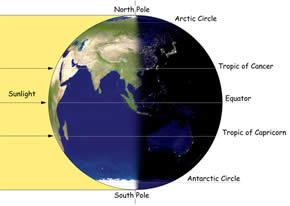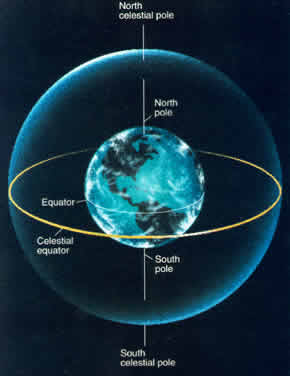Difference between Axis and Poles
Key Difference: The Earth is rotating on its axis (counter-clockwise when analyzed from above the North Pole or west-to-east as analyzed from above the Equator). A pole consists of two points: North Pole and South Pole. The North Pole lies 90° on the north of the equator and the South Pole lies 90° on the south of the equator, respectively.
 An axis may be defined as an imaginary line around which an object spins. Axis is commonly referred to in mathematics. An axis of symmetry is a line, which divides a two-dimensional object into identical shapes. An axis may also be referred to in science, in technology, in music, in industry, in geography, etc.
An axis may be defined as an imaginary line around which an object spins. Axis is commonly referred to in mathematics. An axis of symmetry is a line, which divides a two-dimensional object into identical shapes. An axis may also be referred to in science, in technology, in music, in industry, in geography, etc.
The Earth’s rotation is the best example to understand an axis. Earth rotates from west to east around an imaginary line, which passes through the poles, i.e. north and south poles. It is perpendicular to the plane of the equator. Thus, this imaginary line is called the axis of Earth’s rotation. This is the only reason that the celestial bodies appear to move from east to west. The earth spins on an axis, unlike a top or rolling ball, it does not spin perfectly horizontally or vertically. Instead, it spins at a 23.5 degree tilt. This tilt is also what is responsible for different climates and seasons at different times on the planet.
 A pole consists of two points: North Pole and South Pole. It is the main point where the axis of rotation gets together to the surface of the planet. Lines of longitude all run from pole to pole, and they are all roughly the same length but not parallel, as they converge towards the poles. The North Pole lies 90° north of the equator and the South Pole lies 90° south of the equator.
A pole consists of two points: North Pole and South Pole. It is the main point where the axis of rotation gets together to the surface of the planet. Lines of longitude all run from pole to pole, and they are all roughly the same length but not parallel, as they converge towards the poles. The North Pole lies 90° north of the equator and the South Pole lies 90° south of the equator.
The direction of the Earth’s poles, relative to the Sun, causes the difference in energy received at the Equator and the poles. The normal amount of solar radiation reduces from the Equator to the poles. This is because the low latitudes (near the Equator deliver relatively large amounts of radiation all year, and at high latitudes (near the poles), the more slanting angle of the Sun’s rays together with long periods of darkness in the winter, result in a low amount of received radiation.
Comparison between Axis and Poles:
|
|
Axis |
Poles |
|
Description |
The axis is an imaginary line through both north and south poles on which the Earth rotates. The earth spins on an axis, unlike a top or rolling ball, it does not spin perfectly horizontally or vertically. |
A pole consists of two points: North Pole and South Pole. The North Pole lies 90° north of the equator and the South Pole lies 90° south of the equator. |
|
Tilted |
Perpendicular to the plane of the ecliptic is up and down and the Earth's axis is tilted with respect to that perpendicular. |
Northern and Southern Poles are sometimes tilted toward the Sun and sometimes tilted away from the Sun. |
Image Courtesy: cseligman.com, scienceblogs.com









Add new comment